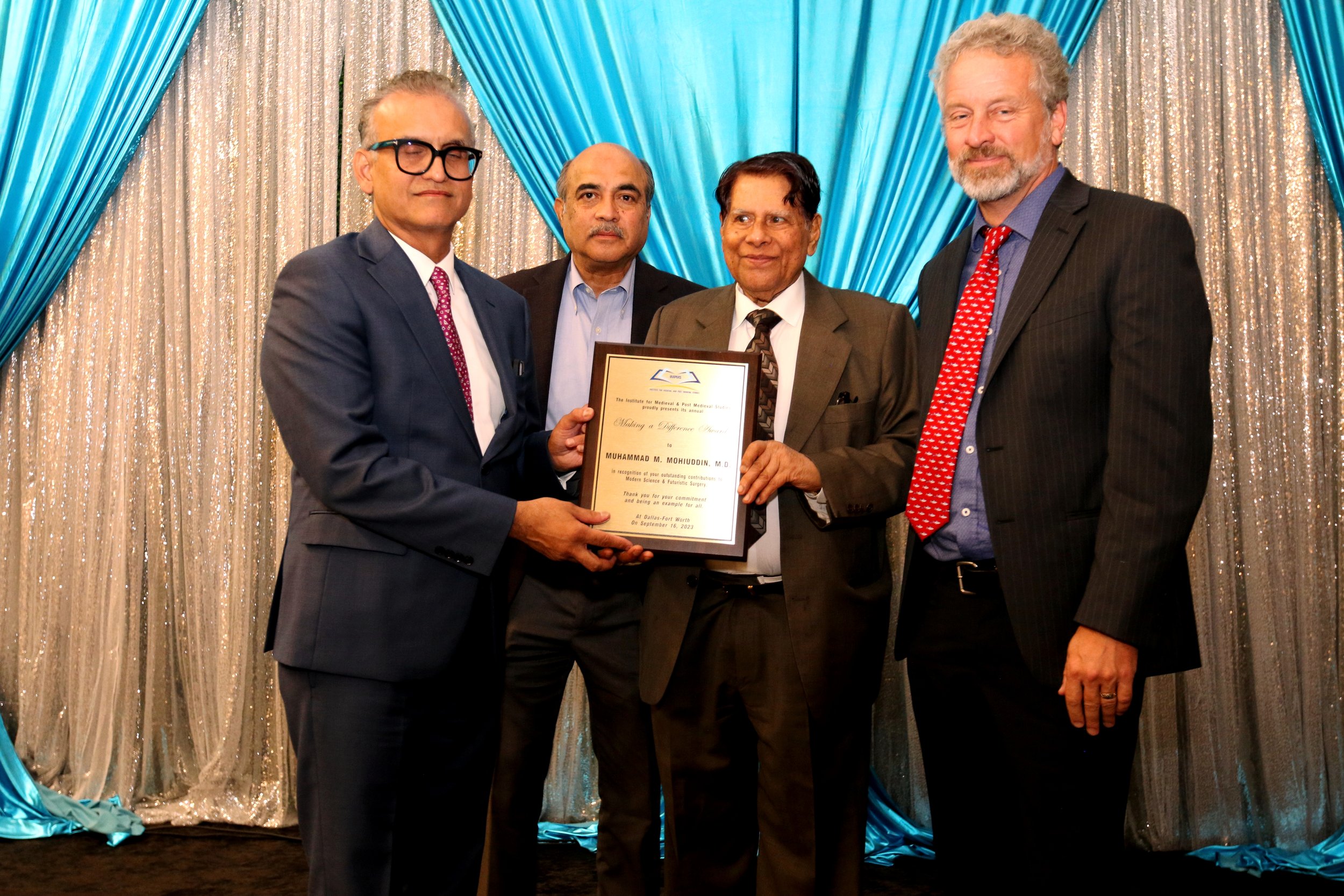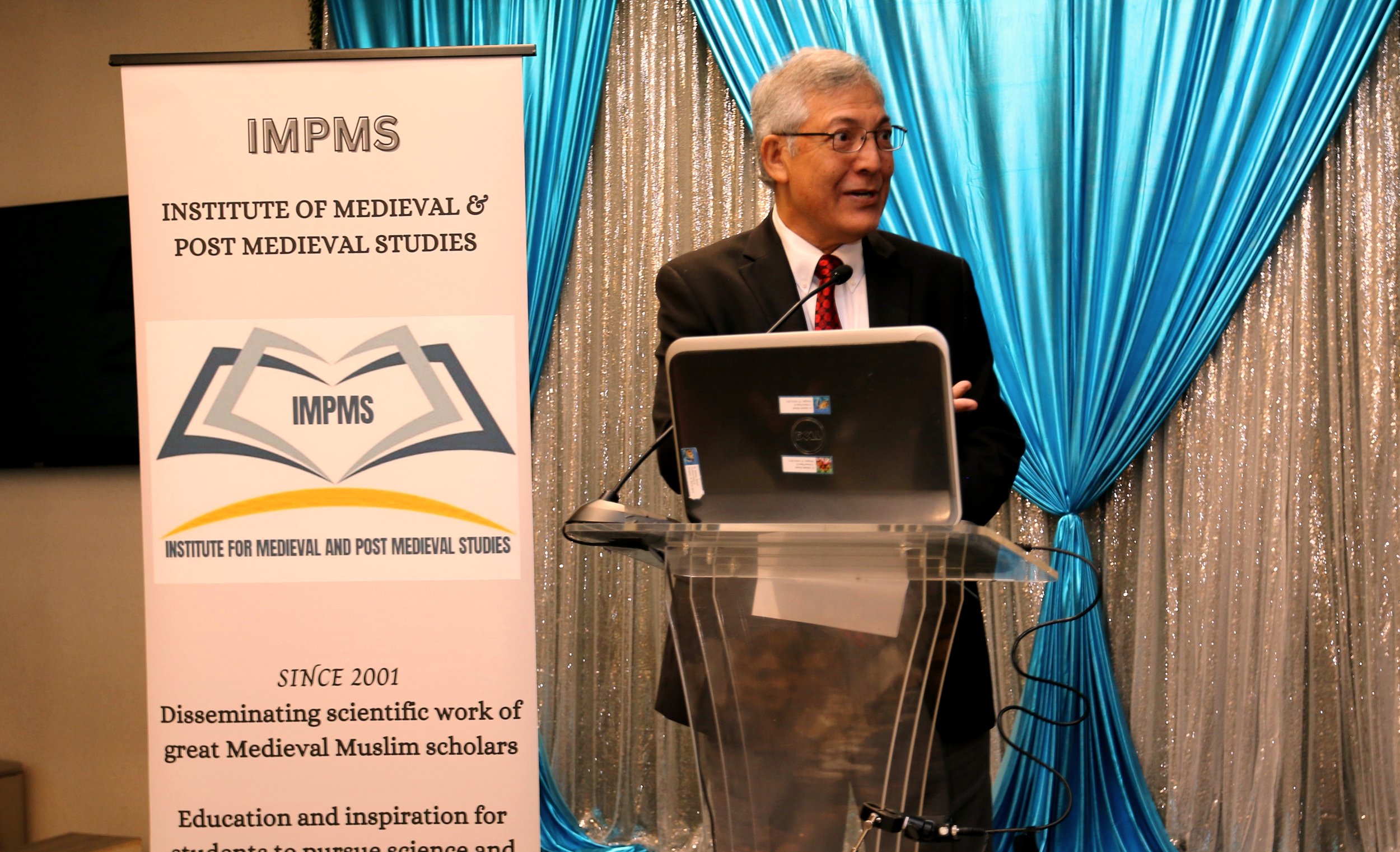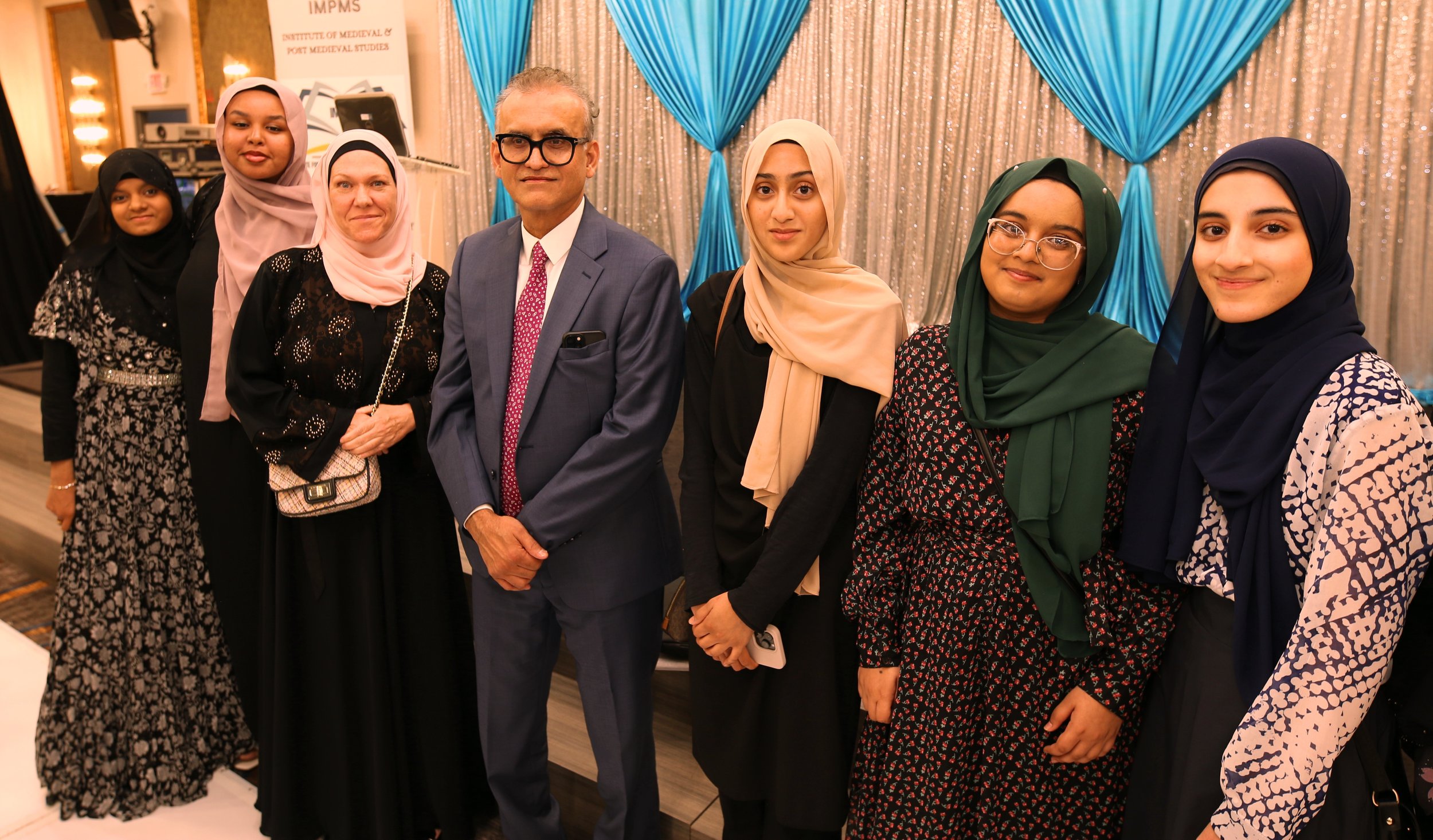
Current Events
IMPMS 2025 Annual Gala:
Artificial Intelligence & The Future
- Bridging Heritage and Innovation
Date: Saturday, October 4, 2025
Location: Hilton Richardson, 701 East Campbell Rd, Richardson, TX 75081
Time: 6:00 PM – 10:00 PM
Join us for an unforgettable evening that blends cutting-edge science with timeless legacy. The Institute of Medieval and Post-Medieval Studies (IMPMS) proudly presents its 2025 flagship event, themed "Artificial Intelligence & The Future: Bridging Heritage and Innovation." This inspiring gathering will spotlight the extraordinary contributions of Muslim civilizations to science and culture - past, present, and future.
What to Expect:
Keynote Address by Babar Bhatti: Explore the ethical frontiers of Artificial Intelligence in a globalized world from a renowned tech leader.
Youth Innovation Panel (DiscoverSTEM): Hear directly from bright young minds about AI-powered solutions and real-world applications.
Interactive Exhibits: Discover the legacy of the Islamic Golden Age through hands-on displays, historical reconstructions, and engaging multimedia.
Networking Opportunities: Connect with scholars, scientists, students, and changemakers from across disciplines and communities.
Cultural Reflection & Recognition: Celebrate trailblazers, sponsors, and rising student stars who are shaping the future of knowledge and innovation.
Dinner, exhibits, and an evening of interfaith and intergenerational exchange await.
Whether you're a student, educator, STEM professional, or lifelong learner - this event will leave you inspired by the enduring impact of Muslim scholarship and energized by the promise of tomorrow’s innovations.
Limited seating – register now and be part of the legacy.
What is AI?
AI, or Artificial Intelligence, is when machines mimic human thinking: learning, reasoning, problem-solving, even creating.
You’ve already met AI:
Siri answering your questions
Netflix suggesting what to watch next
Your phone unlocking with face ID
ChatGPT writing text (like this!)
Cars driving themselves
But it is more than convenience. It is power. AI can detect cancer earlier, help farmers grow better crops, translate languages, or personalize education. It can also raise tough questions: Who controls it? Is it fair? Can we trust it?
That is why IMPMS is stepping in. We help people not only understand AI, but shape it with insight, ethics, and community in mind.
Meet the Visionaries
Babar M. Bhatti – Keynote Speaker
AI Strategist at IBM | Co-Founder of Dallas AI | MIT Graduate
Author of Field Notes for AI Success and Beginner to Executive Prompting Guide (2025). Babar helps global companies lead with AI while asking the big questions: What is right? What is next?
Ben Gold – Panel Moderator
Ben Gold, an AI strategist with over 20 years of technology sales experience, helps organizations navigate the complexities of AI adoption. He bridges the gap between technical concepts and business objectives, enabling companies to harness AI's power for increased efficiency, innovation, and competitive advantage.
Be Part of the Movement
IMPMS is not just about events. It is a community of learners, thinkers, and doers committed to celebrating heritage, championing science, and shaping the future.
Get involved:
Volunteer with us
Join as a member
Support youth, STEM, and ethics-driven innovation
Learn more: www.impms.org
Connect | Inspire | Lead the Future
Dr. Basheer Ahmed with Professor Zafar Anjum and students of UTD at M. Basheer and Shakila Ahmed Science Auditorium.
Dr. Basheer Ahmed with Professor Aziz Sancar, Noble Laurette at UTD.
Dr. Bashoo Naziruddin received a major grant for ISLET cell replacement for type 1 diabetes patients
Proposal Title: A novel approach to overcome innate immunity in beta-cell replacement therapy for type 1 diabetes
Grant period: January 01, 2025 – December 31, 2027
Fund: $750,000 in total for three years
Summary: Insulin is an essential hormone that helps the body to convert blood glucose into energy. Lack of insulin results in high levels of glucose in the blood that can lead to serious health problems. Type 1 diabetes results from immunological destruction and loss of pancreatic islet cells that produce insulin. One of the promising treatments for type 1 diabetes is the transplantation of islets isolated from pancreas from deceased organ donors. Despite documented success of this procedure, its widespread application is limited by the fact that a significant mass of the transplanted islets is lost due to rejection by the patient’s immune system. Furthermore, current islet cell procedures require global immunosuppressant drugs that have toxic effects on islet cells leading to adverse side effects including loss of islet function. Dr. Naziruddin’s team has identified a selective target called toll-like receptor 4 to potently suppress islet immunoreactivity. They plan to use a small molecule called TAK-242 to inhibit toll-like receptor 4. If successful, the team’s proposed research will dramatically improve the islet function with little use of immunosuppression. This would essentially unlock the doors to avenues of more widespread use of clinical islet cell replacement therapies to reverse type 1 diabetes.
Hope the above information is helpful. Please feel free to simplify/edit/revise.
Institute of Medieval and Post-Medieval Studies Annual Event, September 16, 2023
The IMPMS had a highly successful annual event on September 16, 2023. The keynote speaker was Dr. Muhammad M. Muhiuddin, Director of the Cardiac Xenotransplantation Program at the University of Maryland. Last year, Dr. Muhiuddin and his team pleasantly surprised the world by successfully performing the first pig-to-human heart transplant.
Dr. Hyndman, Dean of the School of Science at the University of Texas, Dallas, Dr. Joseph Hill, Chairman of the Department of Cariology at UT Southwestern, and several prominent physicians and community leaders participated in this event. Dr. Joseph Hill and Dr. Muhiuddin made an excellent presentation on the current status of animal heart transplant in human beings to save human lives. Please view the picture of the fundraising event below and in the Gallery tab.
UTD Dedicated the Auditorium to Dr. Basheer and Shakila Ahmed on September 23, 2022
To leave a legacy to inspire generations of students, Dr. Basheer Ahmed and his wife Dr. Shakila Ahmed donated $1 million to The University of Texas at Dallas (UTD) to establish a distinguished chair in the School of Natural Sciences & Mathematics that will support its multicultural students in their students and innovations, reported The American Muslim Today, Oct 6, 2022.
Speaking at the Sept. 30 dedication, Basheer said, “I always had a desire to support the institutions which promote teachings of science and technology. Allah has given me the opportunity to accomplish this goal by supporting UT Dallas which is a great teaching institution and has a great potential to be a top-grade university.”
Basheer, a professor of psychiatry at the University of Texas Health Science Center Southwestern Medical School for several years before moving on to serve as the director of psychiatry departments in various Fort Worth hospitals, retired from the practice in 2005. He helped found the Institute of Medieval and Post-Medieval Studies, the Institute of Quranic Knowledge and Intra-Faith Religious Acceptance, as well as the Muslim Community Center for Human Services, of which he currently serves as chairman emeritus.
His wife Shakila is a board-certified radiologist.
In 1968, the couple migrated to the US from Hyderabad, India.
Dane Richardson (assistant dean, School of Natural Sciences & Mathematics) said this is the first time the university has dedicated a structure to a practicing Muslim. UTD services a significant Asian-American population (32%) and has an international population of 17% with students from South Asia, China, Iran, and Vietnam.
Azhar Azeez (CEO, Musim Aid USA; a former ISNA president), highlighting the Ahmeds’ extensive list of organizations they have founded and their efforts to build interfaith relationships, said, “They both are shining examples of commitment, dedication and outstanding service to humanity and our beloved community. All their life they have strived to build bridges and break barriers.”
Dr. David Hyndman (dean, School of Natural Sciences & Mathematics) said the gift will fund opportunities for growth in science and mathematics, as well as enable thousands of students to engage in research.


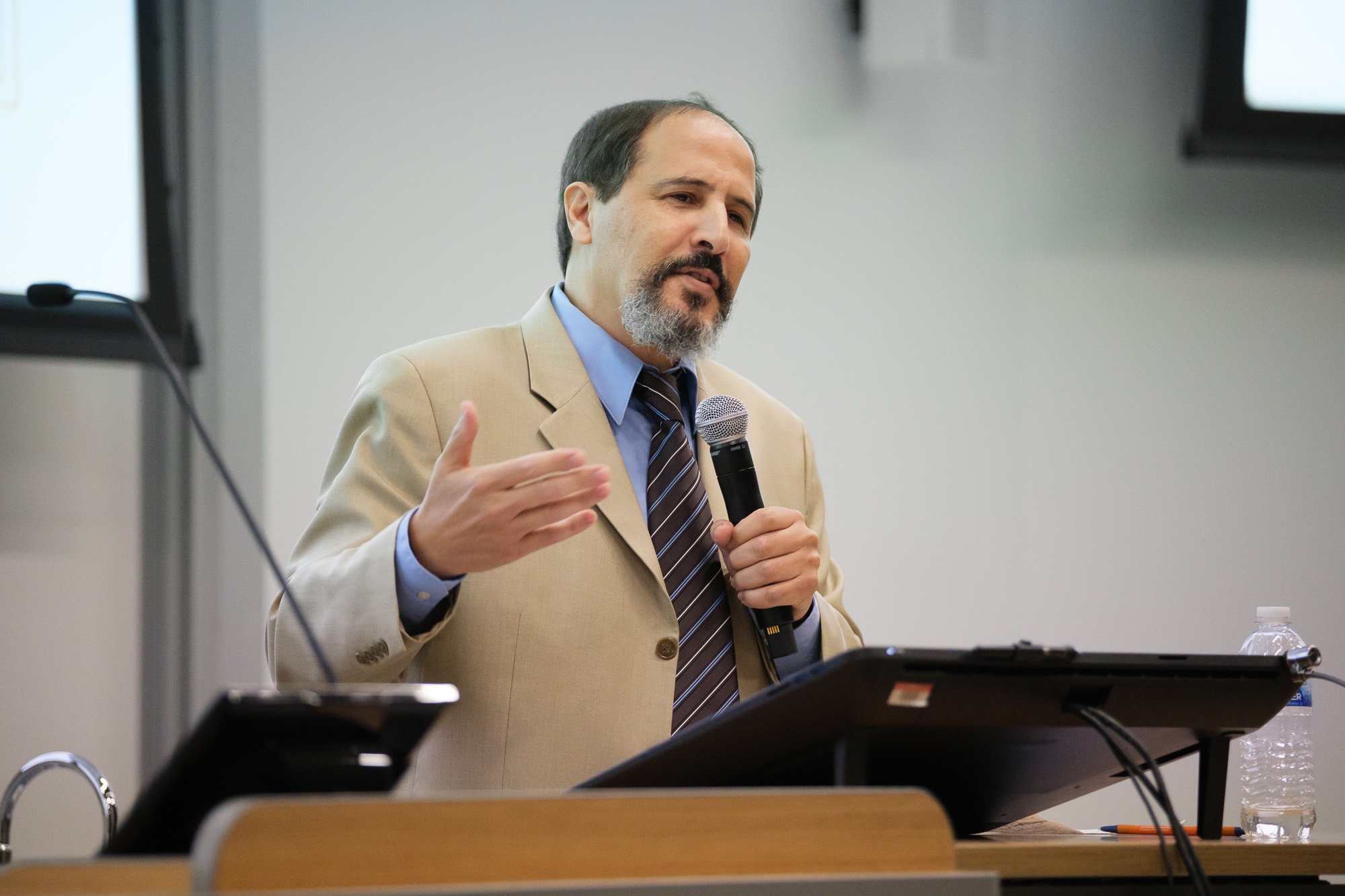
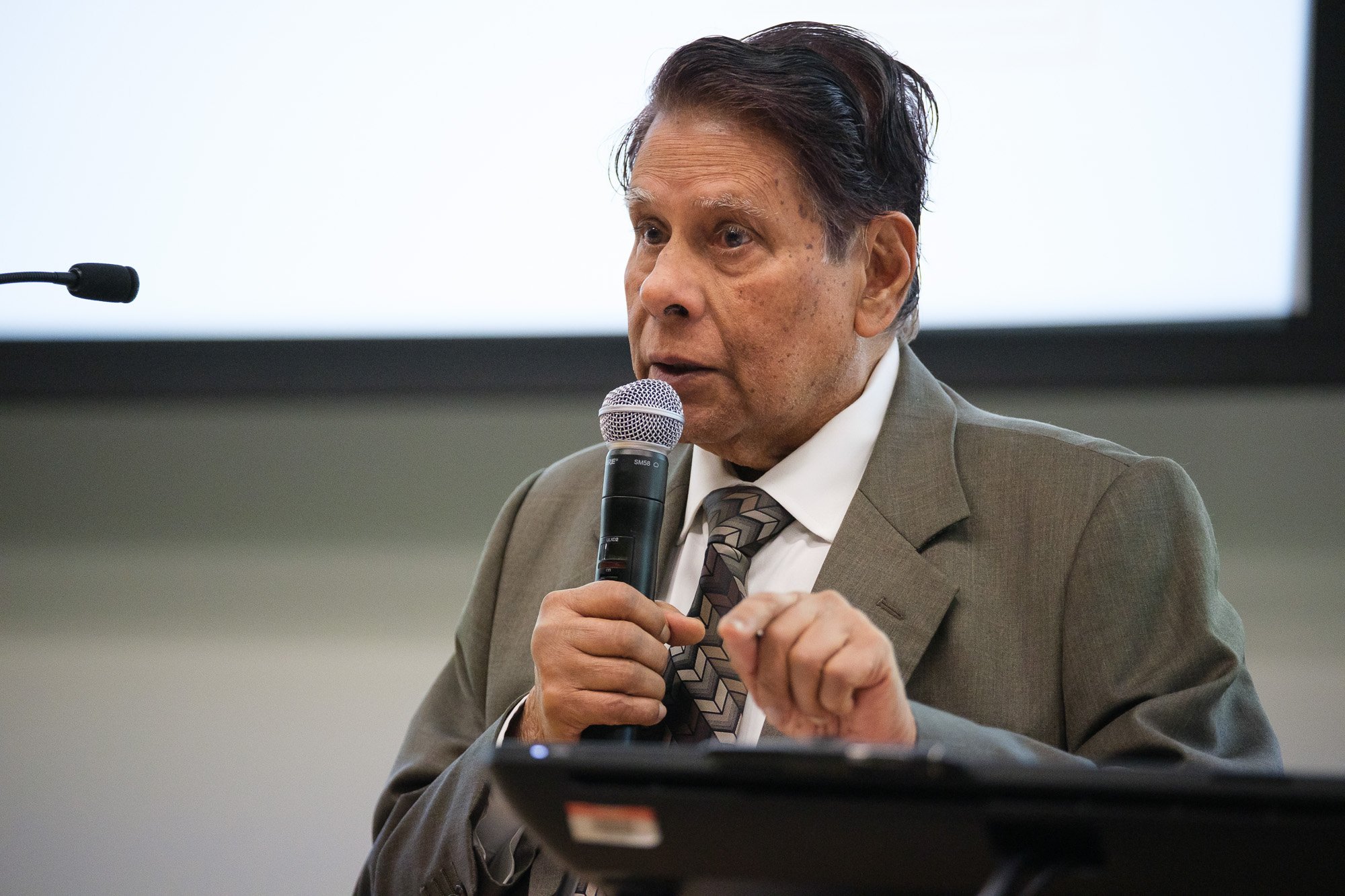

IMPMS Annual Event with Dr. Multu-Pakdil in May 2022
Burçin Mutlu-Pakdil, Ph.D., is a Turkish astrophysicist. Her research has led to a discovery of an extremely rare galaxy with a unique double-ringed elliptical structure, which is now commonly referred to as Burcin's Galaxy.[1] But, the Burçin's Galaxy was one step further! Through extensive imaging and analysis, our astrophysicist Mutlu-Pakdil found that, unlike Hoag's Object, this newly found galaxy has two rings with no visible materials attached to them. It is a phenomenon that no one had ever seen before!
Mutlu-Pakdil grew up in Turkey, where she loved physics and the night sky.[2] She attended Beşiktaş Atatürk Anatolian High School and was the first generation of her family to attend college.[3] She completed her undergraduate studies in physics at Bilkent University in 2009.[4] She moved to Texas Tech University for her graduate studies, gaining a master's degree in physics in 2012.[4] In 2017 she earned her Ph.D. in astrophysics with the dissertation Testing Supermassive Black Hole Scaling Relations Using Cosmological Simulations and Optical/Near-IR Imaging Data from University of Minnesota, Twin Cities.[4][5]
She uses the world's largest telescopes to understand the nature of dark matter and galaxy formation by studying the smallest galaxies.
Research and Career
Burçins Galaxy (right)
In 2017, Mutlu-Pakdil was appointed a postdoctoral research associate at University of Arizona. She worked at the Steward Observatory looking at the structure and dynamics of astrophysical objects, including dwarf galaxies, galactic rings and supermassive black holes.[2] She used telescopes in Chile and Hawaii.[6] At UA, she co-chaired the Women in Astronomy group.[7] She was an American Astronomical Society ambassador.[8]
During her doctoral studies, Mutlu-Pakdil discovered the galaxy PGC 1000714, which has been nicknamed "Burçin's galaxy".[6] It is an extremely rare double ringed elliptical galaxy, and her discovery generated extensive media coverage.[9][10][11][12][13][14][15][16][17]
She worked with the North Carolina Museum of Natural Sciences to create a series of short scientific films for the general public.[9] In January 2018, Mutlu-Pakdil was announced as a TED Fellow.[18] She gave a lecture[19] at TED Vancouver in April, 2018.[6][2] She is a campaigner for the increased representation of Muslim women in science.[6]
In 2019, Mutlu-Pakdil was announced an AAAS IF/THEN Ambassador[20] and in 2020 she became a TED Senior Fellow[21].
As a KICP Fellow, Burcin Mutlu-Pakdil is searching for the most peculiar objects in the Universe.[1] In her own words, Mutlu-Pakdil uses "both large photometric surveys from ground-based and space telescopes in order to discover and characterize the smallest and faintest galaxies in the universe, and the role of dark matter in their formation."[22]




IMPMS Annual Function February 2020
The keynote speaker- Hashima Hasan, PhD, NASA Scientist
Hashima Hasan’s love for space started when as a five-year old she stood in her grand parents’ backyard in Lucknow, India and watched Sputnik go by overhead. She had no idea how she would achieve her dream to become a scientist and attend Oxford University, as her uncle and grand uncles had done. But achieve it, she did. Her ultimate goal to work for NASA materialized in 1994, when she joined NASA Headquarters to manage missions and research programs in Astrophysics. Since then she has been the Program Scientist for twelve flight missions, twice for the Explorer Program, and Lead for the Astrophysics Research and Analysis Program. She is currently a Program Scientist for the James Webb Space Telescope and Lead for Astrophysics Education and Public Outreach. Dr. Hasan’s route to NASA was an unusual one. After winning a scholarship to Oxford and earning a doctorate in Theoretical Nuclear Physics in 1976, she started on a traditional academic path of research and University teaching. Her career was abruptly interrupted when an arranged marriage brought her to USA. Undaunted by the many obstacles she found in her path, she conquered each and continued her scientific career. As changing circumstances demanded, she changed fields from Nuclear Physics to Atmospheric Science to Astrophysics. Her association with NASA started in 1985, when she joined the Space Telescope Science Institute (STScI) in Baltimore, Maryland to simulate the optics of the Hubble and its science instruments. By then she was a mother of two toddler sons and had to juggle her time between home and work. With support from her husband and the management at STScI (and later NASA Headquarters), she maintained a successful career and raised a lawyer and an engineer. Dr. Hasan likes to tell her story to young women graduate students and other professionals to inspire them to pursue their dreams and never give up. As NASA Astrophysics Eduation and Public Outreach Lead, she ensures that the excitement of the science from our missions is communicated to students, teachers, and the public in a way to make them appreciate the new knowledge generated and to inspire the young to go into scientific careers.
Growing up in India, newly liberated from British rule, and at a time when there were few women scientist role models, I still dreamed of being one. When the Russians launched Sputnik and my grandmother gathered the whole family early one morning to see the satellite pass overhead, I wanted nothing more than to explore space. When NASA landed a man on the moon, I promised myself that one day I would work for NASA. Encouraged by my mother and teachers, I strongly believed that if I worked hard I would achieve my goals of going to Oxford University in England and working for NASA in America. I doggedly pursued my dreams and won a scholarship to Oxford University and received my doctorate in Physics in 1976. Joining NASA took a little longer.
The road to a scientific career was not easy. When my girls-only school offered an opportunity for the most talented girls to study science in high school, I worked to earn my chance. Women teachers were difficult to find; my classmates and I often taught ourselves by reading our text books and discussing amongst ourselves. I taught myself mathematics from my brother’s textbooks to qualify for college. Girls were treated with awe at the University, particularly those who excelled in Mathematics. I experienced this even at Oxford, where saying that I was studying Theoretical Physics was such a conversation stopper at parties that I stopped telling people my major! Rather than be discouraged, I was motivated to show to the world that I could be the best. I won the Gold Medal in Physics when earning my Masters Degree, in addition to several prestigious scholarships. After earning my doctorate at Oxford, I returned to India and joined the Tata Institute for Fundamental Research as a research scientist and one of the two female Physicists. A year later, I was selected for the faculty of Poona University.
But new challenges emerged. Although I was financially independent and on a solid career path, I was under tremendous pressure from my family to get married. The only concession my parents gave me was to meet with the men they considered and to give my consent. When my father brought the man who became my husband, we had two hours at the Taj Hotel in Bombay to meet and let my father know our decision. I had to leave a promising career in India and come with my husband to the USA, where immigration visa restrictions closed many doors for me. But I was determined not to give up my science career. I continued my research on a limited basis until we received permission to stay in America. It was sheer will power that helped me keep my scientific abilities alive.
My connection with NASA started in 1985. I joined the Space Telescope Science Institute (STScI) to develop the software simulating the optics of the Hubble Space Telescope (HST) and its science instruments. After it launched and was orbiting the Earth, we realized the mirror wasn’t reflecting clear pictures. I analyzed the errors of the mirror, so that the telescope could be kept in the best focus possible to enable science, till a fix was designed. As a lead woman scientist, I provided mentorship to young women graduate students and technicians. When I see those women well placed in leadership positions today, I feel rewarded.
As a young woman in 1985 with two toddler sons, a first generation American with no family support, and at a time when day care centers and summer day camps were rare, I faced the inevitable challenge of balancing work and family. I got tremendous support from my husband, also a scientist. My sons are now both successful – one as a lawyer, and the other as an engineer. I’m so grateful for support from the management at the Space Telescope Science Institute and later at NASA Headquarters whenever I needed to be home – either with a sick child or any other reason. This part of my life is as much a part of my NASA story as my professional work.
I joined NASA Headquarters in 1994 as a Visiting Senior Scientist to manage the Ultraviolet, Visible and Gravitational Astrophysics program. Thanks to my boss, Dr. Edward Weiler, I learned about grants management, budgets, Program Scientist duties, and how the Federal Government worked. I came to NASA with the intent of getting management experience for a year. It soon became clear to me that working at NASA and serving the public was more a calling for me than a profession. When I saw my first Shuttle launch in 1995, it gave me goose bumps. My second launch was in 1996 when the mission, for which I was the Program Scientist, launched. I have been fortunate enough to be the Program Scientist for several Astrophysics missions, including the Hubble Space Telescope, and now the James Webb Space Telescope. I qualified for the NASA Senior Executive Service (SES) in 2003, after training in the SES Candidate Development Program (SESCDP).
When I think of the unlikely dream I had as a little girl in an under developed country, I marvel at where I am today. Unlike many people, I had no formal mentors while growing up, no one to guide me or tell me what step to take next. In fact, it was an almost hostile environment where a young woman wishing to pursue a scientific career, rather than getting married and raising a family, was viewed with suspicion. What I did have was the knowledge that I was growing up in a free, democratic nation, where I had the same constitutional rights as my brother. I had a mother and school teachers who were motivators. They did not have enough knowledge to provide me direction, but they taught me to believe in myself, to dream and to succeed. If my story inspires others, then I’ve continued their legacy.







